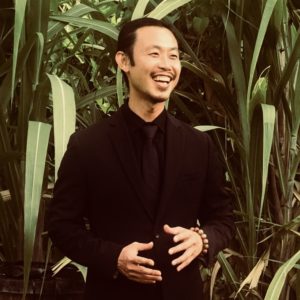
Our Approach
About Dao Center
Dao Center is not just a physical place. It is a point we can return to whenever we need to recenter, wherever we are. Through practical concepts and applied exercises we can gradually strengthen our root within.
Balance Method Acupncture, Ba Zi Birth Chart Analysis, and Dao De Gong Fa Self-Care Cultivation are ways to get and stay centered despite the variable circumstances of our external life.
Our Story
About Paul C. Wang
• Doctor of Acupuncture and Chinese Medicine 中醫針灸師
• California Board Licensed Acupunturist 執照針灸師
• Transmitter of Dao De Gong Fa 道德功法傳人
• Instructor of Balance Method 平衡針法教師
• Sifu of WingChun 詠春拳師傅

Biography
"My life meaning is helping others find theirs."
Dr. Paul Chengpo Wang 王正博 (玄道) is a practitioner of healing, martial, and energy arts with over twenty years of teaching experience in these fields. He is honored to have been able to share his expertise in over 15 countries on five continents.
Degrees
Dr. Wang earned a Bachelor of Arts (BA) in Integrative Biology with an emphasis on human locomotion and biodynamics as well as minor studies in Chinese philosophy from the University of California at Berkeley. He also attained a Master of Science in Traditional Chinese Medicine (MSTCM) and a Doctorate in Acupuncture and Chinese Medicine (DACM), both from the American College of Traditional Chinese Medicine. He is professionally accredited by the California Acupuncture Board as a Board Licensed Acupuncturist (LAc). His official certifications as a Sifu of WingChun (詠春拳師傅), WingChun Fifth Technician Grade (詠春第五級技士), WingChun Combat Instructor (詠春技擊教師), and Escrima Fifth Level (武器第五段士) are conferred from the International Academy of WingChun (IAW).
Teachers
Dr. Wang has many influences he credits towards his personal synthesis of human expression integrated as Dao De Gong Fa. Since youth, he has sought out mentors, teachings, and lineages who merge practical application with logical theory.
His medical influences are from Dr. Richard Tehfu Tan 譚特夫 (Balance Method Acupuncture 天應穴平衡針法, Bazi Birth Chart Analysis), Dr. Wang Ju Yi 王局易 (Channel Palpation and Physiology 經絡檢查), Dr. Young Wei-Chieh 楊維傑 (Tung Diagnosis and Acupuncture 董氏針灸), and Dr. Jimmy Chang 張蔚炎 (Pulsynergy 張氏脈法).
His martial influences are from Sifu Klaus Brand (WingChun 詠春, Escrima), Master Liu Ji Shun 劉積順 (Wu Hao Taiji 武氏郝家太極), Liu Style Qigong Tuina 劉氏氣功推拿), Master Luo De Xiu 羅德修 (Gao Style Bagua 高氏八卦), Master Shu Dong Chen 蘇東成 (Essence of Evolution), and Hong Zhongnan (Wu Style Taiji 吳家太極拳), Master Fong Ha (Yiquan 意拳).
His spiritual influences are from Master Duan Zhi Liang 段智良 (Wuji Hundun Qigong 無極混沌氣功), Sifu Share K. Lew (Dao Dan Pai 道丹派), Master Wang Liping 王力平 (Longmen Pai 龍門派), Master Zhongxian Wu 吳忠賢 (Emei Zhengong 峨眉真功), Master Shou-Yu Liang 梁守渝 (Daoist Cultivation 道家修煉), Master Yunxiang Tseng (Wudang Sanfeng Pai 武當張三豐派), and Master Robert Peng.
Dr. Wang is also influenced by historical figures who have integrated martial, medical, and mystical practices, especially Mo Zi 墨子, Ge Hong 葛洪, Sun Si Miao 孫思邈, Zhu Dan Xi 朱丹溪, and Chen Tuan 陳摶 in the Chinese tradition, practical philosophers such as Seneca, Epictetus, Pythagoras, and Leonardo da Vinci in the Western tradition, as well as integrative thinkers like Fritjof Schuon, Franklin Merrell-Wolff, Paul Brunton, Benisa Duono, Victor Frankl, Swami Vivekananda, and Sri M in more contemporary times. His cultivation and instruction encompasses aspects of all the above mentioned systems and their exemplary masters.
Interests
When Dr. Wang is not traveling around the world to teach or treat patients, he enjoys training and being in nature, meditation, and retreat. Besides application of classical acupuncture, Chinese medicine, neigong, martial arts, calligraphy, guqin, and perennial philosophy, his interests include scientific findings in photobiology, quantum biology, the autonomic nervous system, the mirror neuron system, the microbiome, telomeres, epigenetics, mitochondrial disease, intergenerational trauma, and the fundamental forces.
About Emblem
Our emblem incorporates symbolic meanings from ancient and modern paradigms of the East and West.
The upper and lower curves represent several monograms including the D and C of Dao Center, the P and C of Paul Chengpo (Wang), and the D and D of Dao De (Gong Fa). The Chinese character for the surname Wang (王) is also evident.
The spiral wave represents the cycle, flow, and dynamic of relative polar duality (yīnyáng 陰陽) in space, time, matter, and energy.
The vertical line represents the eternal present, axis mundi, and self-alignment as well as a spine, staff, sword, string, needle, brush, gnomon.
The horizontal lines represent the first three numbers one (yī 一), two (èr 二), three (sān 三), the three realms of Sky (tīan 天), Human (rén 人), and Earth (dì 地), the three aspects of physical (jīng 精), emotional (qì 氣) and mental (shén 神), and the three levels, or yáo (爻), of the Eight Trigrams (bāguà (八卦), which are depicted as ☰☱☲☳☴☵☶☷.
The cross represents the daily, monthly, and yearly transitions, the cardinal directions and their center of nonpolarity (wújí 無極), the Five Phases (wǔxíng 五行), the Five Elements (Earth, Water, Air, Fire, Ether), the spokes on the wheel of life, and the intersection of horizontal with vertical, microcosm with macrocosm, individual with universal, and the concept “as above, so below”.
Colorwise, black and white are used as complementary contrasts whereas green (#177245 dark spring green) is featured as a balancing highlight because it lies at the center of the visible spectrum. Green is also the color of the middle chakra (Anāhata) and the northern Dhyani Buddha (Amoghasiddhi). Furthermore, jade (yù 玉) is considered a sacred stone in many cultures.
Next Step
View upcoming opportunities to train Gong Fa with Dr. Paul C. Wang.
